The 2022 CISQ report found that poor software quality costs the U.S. $2.41 trillion annually, with security flaws accounting for most system outages. For example, the 2021 Azure outage caused by a DNS misconfiguration highlighted how misjudging severity vs. priority can escalate minor errors into global crises.
Assume your team deploys a critical update to a cloud-based SaaS platform. Hours later, monitoring tools flag a security vulnerability (e.g., unpatched SQL injection) that exposes user data. Simultaneously, customers report a broken API integration disrupting third-party services. Which issue gets resolved first? The answer lies in understanding bug severity (technical harm) and bug priority (business urgency).
This guide will equip engineers to:
- Classify bugs using severity levels (critical, high, medium, low).
- Align fixes with business priorities (launch deadlines, customer impact).
What is Bug Severity?
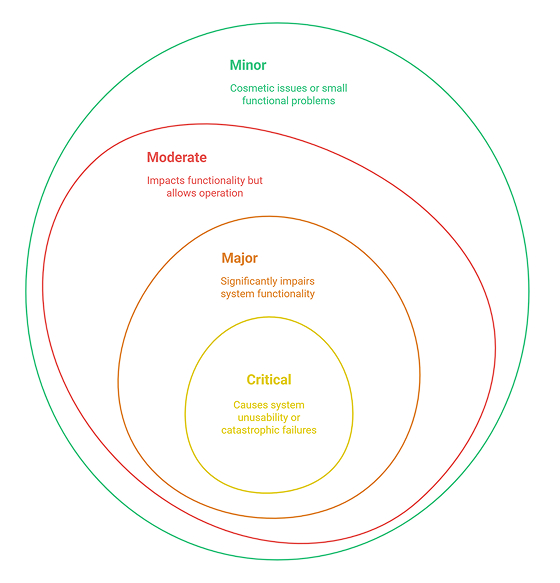
Bug severity refers to how much a defect disrupts a system’s core operations. Think of it as a way to gauge the “damage” a bug causes.
For example, a critical bug might crash an app entirely, while a low-severity issue could be something like a button color being slightly off.
Teams use severity levels to decide which bugs need immediate attention-like fixing a login failure. It’s purely about the technical impact, not deadlines or user complaints. This helps developers tackle problems that truly risk breaking the system first.
Bug Severity Levels
Severity is typically classified into the following levels:
1. Critical: These bugs render the system unusable or cause catastrophic failures.
- Complete system crashes
- Data corruption or loss
- Security vulnerabilities that expose sensitive information
- Functionality that, when broken, makes the core product unusable
2. Major: While not causing complete failure, these bugs significantly impair system functionality.
- Important features work incorrectly
- Calculations produce wrong results
- Major performance degradation
- Partial data loss or corruption
3. Moderate: These bugs impact functionality but don’t prevent the system from operating.
- Minor calculation errors
- UI elements are displaying incorrectly but are still usable
- Occasional unexpected behavior that doesn’t affect core operations
- Inefficient processes that don’t critically impact performance
4. Minor: These are cosmetic issues or small functional problems with easy workarounds.
- Typos or grammatical errors
- Misaligned UI elements
- Non-critical formatting issues
- Minor usability inconveniences
The severity assignment follows technical criteria and should remain relatively objective across different observers examining the same bug. If two testers see the same bug crashing a core feature, they both should call it “critical.”
What is Bug Priority?
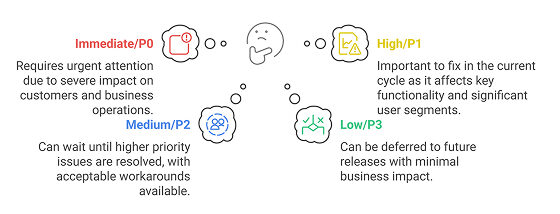
Bug priority concerns urgency and how quickly a bug needs fixing based on real-world factors. Even a minor typo on a homepage might get high priority if the site launches tomorrow, while a major but hidden glitch in a rarely used feature could wait.
Priority balances business goals, deadlines, and user needs. For instance, a bug that annoys 90% of users might jump the queue, even if it’s not technically severe. Unlike severity (which is technical), priority answers the question: “When should this get fixed to keep things moving?”
Categories of Bug Priority
Bug priority typically falls into four categories of bugs:
1. Immediate/P0: Requires immediate attention and dedicated resources until resolved.
- Affects a large number of customers
- Blocks critical business operations
- Creates significant revenue loss
- Damages the brand reputation
2. High/P1: This should be fixed in the current development cycle.
- Affects important customers or a significant user segment
- Compromises key product functionality
- Impacts important business metrics
- Creates customer dissatisfaction with cumbersome workarounds
3. Medium/P2: This should be addressed after higher-priority issues.
- Affects functionality used by a smaller segment of users
- Has acceptable workarounds
- Does not significantly impact key business metrics
- It can reasonably wait until the next development cycle
4. Low/P3: This can be deferred to future releases.
- Affects rarely used features
- Has minimal business impact
- Simple workarounds are available
- Fixing would provide a minimal return on investment
Product managers might push for deadlines, and customer support reps could flag complaints from angry users. Deciding which bugs to fix first isn’t just up to engineers. It’s a team sport.
Bug Severity vs. Bug Priority
Severity is a technical assessment, while priority is a business decision. A critical bug in a rarely used feature (high severity, low priority) might be deprioritized, whereas a medium severity bug affecting VIP users could escalate to the P1 (Priority-1) level.
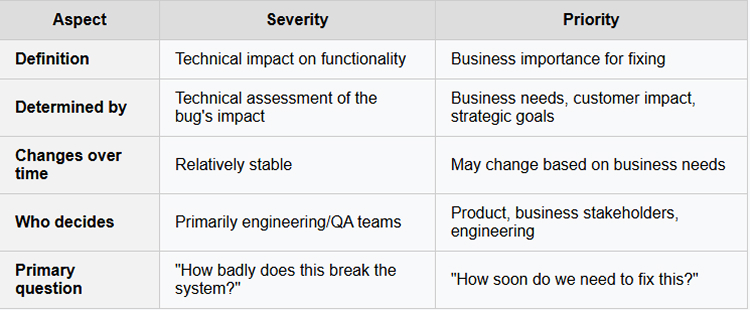
Teams often use a bug severity vs. priority matrix to visualize this interplay.
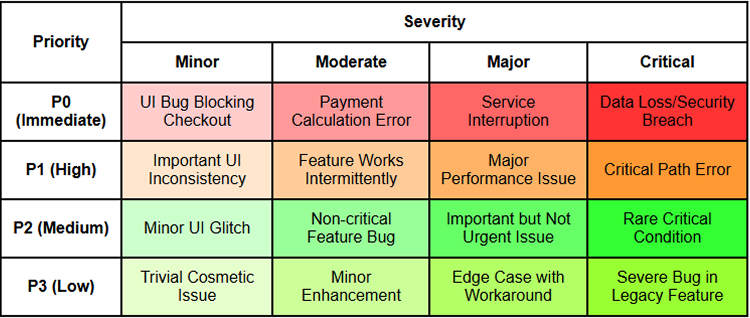
Examples Illustrating the Interplay
- High severity/High priority: A critical security vulnerability in a payment system that allows unauthorized access to financial data. This requires immediate attention due to both its technical severity and business impact.
- High severity/Low priority: A major bug in a legacy feature used by very few customers that is scheduled for deprecation next month. Despite its technical impact, business considerations don’t justify immediate resources.
- Low severity/High priority: A minor UI alignment issue on the company’s homepage right before a major product launch. While technically minor, the business context elevates its priority.
- Low severity/Low priority: A spelling error in an admin panel is only visible to internal staff. Neither technically impactful nor business-critical.
This interplay highlights why engineering teams must consider both dimensions when planning their bug-fixing strategies.
Types of Bugs in Software Testing
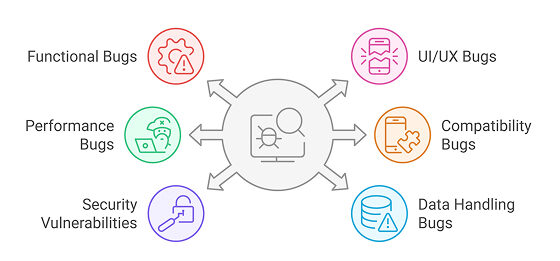
Understanding the different types of bugs helps teams recognize patterns and implement more effective prevention strategies. Here are the primary types of bugs encountered in software testing:
1. Functional Bugs
- Causes: Flawed logic, incomplete requirements, or coding errors.
- Detection: Unit tests, integration testing, user acceptance testing (UAT).
- Example: A “Save Draft” feature fails to store data.
- Prevention: Behavior-driven development (BDD) frameworks like Cucumber.
2. UI/UX Bugs
- Causes: Inconsistent design implementation and responsive layout failures.
- Detection: Cross-browser testing tools (e.g., BrowserStack), accessibility checkers.
- Example: Overlapping text on mobile screens.
- Prevention: Style guides and design system adherence.
3. Performance Bugs
- Causes: Poorly optimized queries, memory leaks, inadequate scaling.
- Detection: Load testing (JMeter), profiling tools (New Relic).
- Example: API latency exceeding 5 seconds under 10k concurrent users.
- Prevention: Auto-scaling cloud architecture and code reviews for efficiency.
4. Compatibility Bugs
- Causes: Browser-specific CSS/JS behaviors and device driver issues.
- Detection: Cross-platform testing suites (Selenium Grid).
- Example: iOS app crashes on iPhone 15 due to unpatched OS dependencies.
- Prevention: Regular updates to testing matrices.
5. Security Vulnerabilities
- Causes: Unsanitized inputs, weak encryption, misconfigured permissions.
- Detection: Penetration testing, SAST/DAST tools (OWASP ZAP).
- Example: SQL injection in a login form.
- Prevention: Regular security audits and DevSecOps pipelines.
6. Data Handling Bugs
- Causes: Race conditions, improper transaction handling.
- Detection: Database monitoring (e.g., PostgreSQL logs).
- Example: Duplicate entries created during high-traffic registration.
- Prevention: ACID-compliant database design and isolation levels.
Best Practices for Managing Bugs
1. Establish clear definitions: Create unambiguous definitions for each severity and priority level that everyone in the organization understands and applies consistently.
- Document specific examples for each level.
- Include decision trees to guide classification.
- Review and refine definitions periodically based on team feedback.
2. Implement a structured triage process: Develop a repeatable process for evaluating new bugs.
- Schedule regular triage meetings with cross-functional representation.
- Use a standardized bug report template that captures all necessary information.
- Ensure technical and business stakeholders are involved in priority decisions.
3. Prioritize effectively: Use both severity and priority to make informed decisions.
- Create a matrix (as shown above) to guide decision-making.
- Avoid the trap of treating all high-severity bugs as high-priority.
- Consider business context, release schedules, and resource constraints.
4. Track and analyze trends: Look beyond individual bugs to identify systemic issues.
- Monitor bug categories and components with recurring issues.
- Analyze root causes across similar bugs.
- Implement preventative measures based on trend analysis.
5. Set appropriate SLAs (Service Level Agreements): Establish response and resolution time targets based on severity and priority.
- Define maximum resolution times for each severity-priority combination.
- Track and report on SLA compliance.
- Adjust resource allocation based on SLA requirements.
6. Maintain transparency: Ensure stakeholders understand bug status and plans.
- Provide accessible dashboards showing bug counts by severity and priority.
- Communicate expected fixed timelines clearly to affected parties.
- Document rationale for priority decisions.
These practices help teams move from reactive bug-fixing to proactive quality management, ultimately reducing both the number and impact of bugs.
Wrapping Up
Bug severity and priority are two sides of the same coin. Severity defines technical risk, such as a security flaw that exposes data or a crash that halts workflows. Priority reflects business urgency, like a critical feature failure or a branding typo on a high-traffic page. Misjudging either can lead to costly outcomes. Unresolved critical flaws deteriorate user trust, while misplaced priorities waste resources on trivial fixes.
A critical-severity bug in a rarely used feature might be able to wait. At the same time, a low-severity typo on a landing page during a product launch could demand immediate action. By categorizing bugs clearly (functional, performance, UI, etc.) and aligning teams on severity levels (critical, high, medium, low) and priority categories (immediate, high, medium, low), engineers and managers can clearly decide what they should address first.

